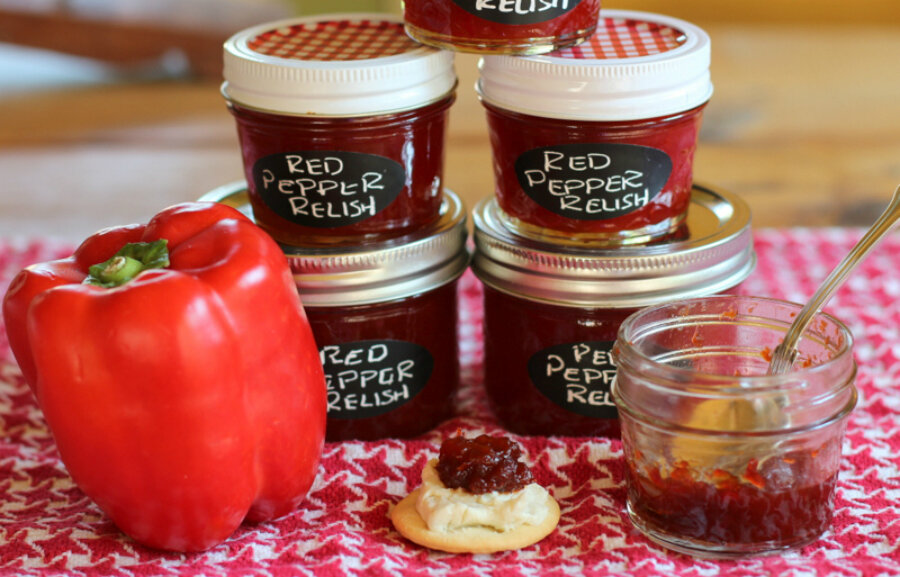Red pepper relish
Loading...
I love good pepper jelly, the wobbly kind with little bits of pepper suspended in the jar. The kind ladies used to bring to the Christmas party to serve over cream cheese, the jar topped with a pretty little cloth circle. And as much as I love canning, jelly, made with exact amounts of liquid and pectin, are a little bit out of my league.
So when I saw this simple recipe in a community cookbook, I wanted to try it, as it seemed to have everything that would produce the flavor of a good pepper jelly. In the cookbook, the recipe was titled Red Pepper Hash, but I don’t think that term really describes what this is and when I once labeled a jar red pepper jam, I could tell the recipient was very skeptical. So I went with relish. I think I like this better than classic jelly. It has more character, with body and heft and a nice tang from the vinegar, perfectly balanced with sugar. This has become a yearly ritual for me, because it is often requested by friends. I have one friend who squeals every time I give her a jar, and she keeps it hidden for her own personal use.
Try this on a burger instead of ketchup for a really interesting twist. In fact it is good on any kind of sandwich. I often serve it with a board of Southern cheeses and locally made charcuterie, but my favorite use is still poured over cream cheese. I just like to make the cream cheese from scratch now, too.
Red Pepper Relish
12 red bell peppers
1 tablespoon kosher salt
2 cups cider vinegar
2 cups granulated sugar
1. Remove the stem, seeds and ribs from the peppers and cut the flesh into chunks. In about three batches, place the pepper in the bowl of a food processor and pulse until all the peppers are finely chopped. Scrape each batch into a colander set over a large bowl. When all the peppers are in the colander, stir in the salt and leave to drain overnight. Cover the colander with a tea towel.
2. When ready to make the relish, place a small ceramic plate in the freezer. You’ll use this this to test the set of the jam later. Then get your jars clean. You will need 3 half-pint mason jars. I always clean a couple of extra just in case. I clean the jars and the rings in the dishwasher, and leave them in there with the door closed to stay warm. You can’t put the lids in the dishwasher, it will ruin them.
While your relish is cooking, get a boiling water canner or big stockpot of water going. Here are step-by step instructions for processing in a canner. When the relish is almost ready, pour some boiling water over the lids to your jars to soften the seals and set aside.
3. Scrape the drained pepper pulp into a large pot and stir in the vinegar and sugar. Bring to a boil, then lower the heat to a simmer and cook until thick and jammy, about 30 – 40 minutes, stirring frequently, and more at the end as the relish thickens. Watch carefully, as the cooking time can vary depending on the density and moisture in the peppers. If there are any large pieces of pepper in the pot, you can use an immersion blender to break them up.
4. When the jam has cooked down and is thickened, pull that little plate out of the freezer and spoon a little jam onto it. Leave to set for a minute, then tilt the plate. If the jam stays put, or only runs a little bit, it’s ready to go. Also, run a finger through the jam on the plate if the two sides stay separate and don’t run back together, you’re good to go.
5. Fill each of your warm, cleaned jars with the relish, leaving a ½ inch head space. Wipe the rims of the jars with a damp paper towel. Dry the lids with a clean paper towel and place on the jars. Screw on the bands tightly, then process the jars for 5 minutes in a boiling water bath. If you have a bit of extra relish, scoop it into a refrigerator container and keep in the fridge for up to a week.
6. When the jars are processed, leave to cool on a towel on the counter.
7. The processed jars will keep for a year in a cool, dark place. Don’t forget to label your jars!
Related post on The Runaway Spoon: Farmers market tart







